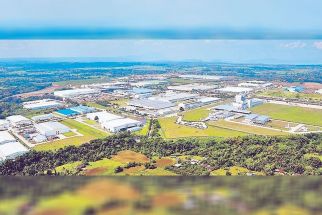Justice

I was in Marinduque for less than 48 hours, arriving in the middle of the night after a long arduous bus ride from Manila and standing room-only ferry trip from Quezon. The time I spent there was enough for me to see and hear the stories of residents affected by the Marcopper Mining spill, dubbed as one of the worst mining disasters in the world.
I went there sometime in 2017 to do a story on affected residents’ long quest for justice. The disaster struck on Dec. 6, 1993, but the buildup was already happening in the years prior to that.
I took several tricycle rides to different barangays situated along the Boac River and there, residents showed me remnants of the spill – the river itself looked brown and dirty and all murky. It’s as if the spill just happened.
As I trudged my way toward muddy, uneven paths to talk to affected residents in one of the barangays, my guide showed me streaks of the spill, which stood out against the dark brown patches of mud – yes they were still so visible decades after. These are rainbow-like kaleidoscopes of colors, blue, red, green and yellow in swirling patterns. It’s that disturbing beauty that often characterizes industrial waste, a mixture of oil, water, and other chemicals.
One could also still see the damage to the environment – deteriorated and dark agriculture fields, almost like dystopian land.
The Marcopper story
The now defunct Canadian company, Marcopper Mining, officially started its copper operations in 1969. Marcopper’s parent firm is Placer Dome, and according to published articles – including an August 2010 decision of the United States Supreme Court in the 1960s, Placer Dome allegedly gave then-president Ferdinand Marcos Sr. a personal 49 percent ownership interest in Marcopper.
“Allegedly in exchange for that interest, Marcos overturned the protected status of a forest reserve under which Placer Dome wished to mine,” according to the US Supreme Court document.
Marcopper operated at the Mt. Tapian ore deposit in Marinduque Island. When the deposit was depleted, Marcopper moved its operations to the San Antonio mine site, three kilometers north of Mt. Tapian, say different articles available online.
The company discharged the mine tailings from Mt. Tapian into Calancan Bay in the province.
In all, the government estimated that the toxic tailings waste killed P1.8 million worth of freshwater, and left for dead Marinduque’s 27-kilometer Boac River.
It is estimated that at least 200 million metric tons of toxic mine tailings were discharged, according to a United Nations team that investigated the disaster.
Snow from Canada
It was said that when exposed to ocean breezes, the tailings, which partially floated, became airborne and landed on rice fields and village homes. Local residents called this their “snow from Canada,” according to an online article by Alex Felipe.
When disaster struck
On that fateful day of Dec. 6, 1993, Typhoon Monang struck and breached the dam, inundating areas in the towns of Mogpog, Boac, and Sta. Cruz.
“Barangays Bocboc and Magapua in Mogpog were submerged in floodwater, causing extensive damage to properties and agriculture,” according to a court decision dated May 16, 2022 which ruled in favor of at least 30 plaintiffs who sued the mining company.
A few days ago, I was pleasantly surprised to hear about this landmark decision that took decades in the making. This is a victory for all of us.
My thoughts immediately travelled all the way back to the province, the people I met and those patches of tailings I saw, which were still visible after all those years.
Judge Emmanuel Recalde of Branch 38 of the Marinduque Regional Trial Court granted P200,000 in temperate damages and P100,000 in moral damages to each of at least 30 plaintiffs in the case filed in 2001. Another P1 million as exemplary damages was awarded to all the plaintiffs, according to a statement sent by the Legal Rights & Natural Resources Center, which served as the legal counsel of the plaintiffs.
“This is a victory for the plaintiffs who had waited two decades for justice, as much as it is for the other plaintiffs who had unfortunately died in the course of this case. We celebrate this ruling and thank Judge Emmanuel Recalde for taking up (the) cudgels for the survivors and the environment,” said Elizabeth Manggol of the Marinduque Council for Environmental Concerns (MACEC).
Warning
“This emblematic case should serve as a warning for communities who wish to embrace mining. Litigating mining-related cases like this celebrated case is a slow march to justice. Communities must think their decisions through for the impact of the environment can be irreversible. In the case of Marinduque, the river affected by the spill is all but dead. With this ruling, Judge Recalde has shown that environmental cases do have a fighting chance in our judicial system,” said lawyer Ryan Roset, direct legal services coordinator of LRC.
For sure, large-scale mining projects present inevitable damage despite the thousands of jobs it creates.
May this decision indeed serve as a lesson to the government, local governments, and different companies, especially with projects involving the country’s natural resources.
Iris Gonzales’ email address is [email protected]. Follow her on Twitter @eyesgonzales. Column archives at eyesgonzales.com.
- Latest
- Trending





























